Why is the moment of inertia (wrt. the center) for a hollow sphere higher than a solid sphere (with same radius and mass)?
A hollow sphere will have a much larger moment of inertia than a uniform sphere of the same size and the same mass.
If this seems counterintuitive, you probably carry a mental image of creating the hollow sphere by removing internal mass from the uniform sphere. This is an incorrect image, as such a process would create a hollow sphere of much lighter mass than the uniform sphere. The correct mental model corresponds to moving internal mass to the surface of the sphere.
The key is... the closer the mass to the axis of rotation, the easier it is to add angular velocity to the body.
For instance a figure skater rotates faster when she puts her limbs closer to her body.

Let's see how it works in a more intuitive fashion:
For instance, in the figure bellow, trying to lift up table (A) would be easier than table (B).
In both cases the mass of each individual box is the same, but in (A) you have a better lever because of the distance from the border where the force is being applied, to each box.
Therefore, table (B) would be harder to lift up, even when R (length of the table) and M (total mass of the four boxes) are the same.

Now let's see how it works in the case with the spheres:
- Let's make the sphere a disk, and then divide it in pieces.
- Make the center of mass of the disc fixed, and move all the pieces to one side.
- Now we have a similar scenerario to the one with the tables.
Both spheres, the solid and hollow one, rotate around their center of mass in the same way that the table rotates around the legs at the opposite side to where the force is being applied.

To make sense of step 2, where the mass of the all pieces is collapsed, think on a Merry-Go-Round where all the kids move to one side keeping their distance to the axis of rotation fixed.

Here's an illustration of a uniform sphere and a hollow sphere mid-sections with the same mass, if you better understand these things visually:
